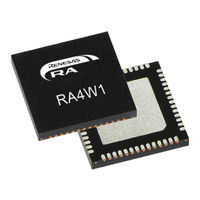Renesas RTK7EKA4W1S00000BJ Manuals
Manuals and User Guides for Renesas RTK7EKA4W1S00000BJ. We have 1 Renesas RTK7EKA4W1S00000BJ manual available for free PDF download: User Manual
Renesas RTK7EKA4W1S00000BJ User Manual (1317 pages)
32-bit MCU
Brand: Renesas
|
Category: Microcontrollers
|
Size: 17 MB
Table of Contents
-
Features
47 -
1 Overview
48-
Pin Lists61
-
2 Cpu
64-
Overview64
-
Debug64
-
-
Debug Mode67
-
-
Reset67
-
-
References78
-
-
-
Overview80
-
-
6 Resets
87 -
-
Overview99
-
Usage Note108
-
-
-
Overview109
-
-
Monitoring Vdet0113
-
Monitoring Vdet1113
-
-
-
-
Overview117
-
-
PLL Circuit146
-
Internal Clock146
-
USB Clock (UCLK)148
-
Clocks for BLE149
-
Usage Notes149
-
-
-
Overview151
-
-
Operation157
-
Usage Note159
-
-
-
Overview160
-
-
Sleep Mode179
-
Snooze Mode183
-
Usage Notes189
-
Register Access189
-
I/O Port States190
-
-
-
-
Overview193
-
-
Operation204
-
Usage Notes208
-
-
-
Overview209
-
-
-
Overview210
-
-
Vector Table223
-
Event Number224
-
Reference234
-
-
15 Buses
235-
Overview235
-
-
Main Buses236
-
Slave Interface236
-
-
References242
-
-
-
Overview243
-
-
Arm MPU251
-
Bus Master MPU251
-
Operation256
-
Bus Slave MPU259
-
-
Functions264
-
-
Security MPU264
-
-
Notes on Debug273
-
-
References273
-
-
-
Overview274
-
-
Operation285
-
Interrupts299
-
Event Link300
-
Usage Notes301
-
-
-
Overview302
-
-
Operation311
-
Interrupt Source325
-
Event Link325
-
-
-
Overview327
-
Operation333
-
Usage Notes334
-
-
20 I/O Ports
335-
Overview335
-
Operation342
-
Usage Notes345
-
-
-
Overview361
-
Usage Notes366
-
-
-
Overview367
-
-
Operation409
-
Basic Operation409
-
Buffer Operation420
-
-
Usage Notes486
-
-
-
Overview489
-
-
Operation498
-
Timer Mode500
-
Standby Mode507
-
Usage Notes508
-
Digital Filter509
-
-
-
Overview511
-
-
-
(Bcnt0Cp0)534
-
-
Operation537
-
Setting the Time538
-
Alarm Function541
-
Usage Notes547
-
-
-
Overview550
-
Operation556
-
-
Auto Start Mode558
-
Reset Output561
-
-
Usage Notes562
-
-
-
Overview563
-
Operation568
-
Auto Start Mode568
-
Status Flags570
-
Reset Output571
-
-
Usage Notes572
-
-
-
Overview573
-
-
Operation620
-
System Control620
-
-
BRDY Interrupt629
-
NRDY Interrupt632
-
BEMP Interrupt634
-
VBUS Interrupt637
-
Resume Interrupt638
-
OVRCR Interrupt638
-
BCHG Interrupt638
-
DTCH Interrupt638
-
SACK Interrupt638
-
SIGN Interrupt638
-
ATTCH Interrupt638
-
EOFERR Interrupt638
-
-
Pipe Control639
-
Transfer Types640
-
Endpoint Number640
-
Response PID641
-
OUT-NAK Mode642
-
Pipe Schedule655
-
-
Usage Notes661
-
-
-
Overview663
-
-
-
(Scmr.smif = 0)670
-
(Scmr.smif = 1)672
-
(Scmr.smif = 0)673
-
(Scmr.smif = 1)675
-
-
-
Clock709
-
-
-
-
-
-
Overview791
-
-
Operation817
-
Wakeup Function840
-
-
-
Overview866
-
-
-
Clock Setting905
-
Bit Time Setting905
-
-
-
Reception910
-
Transmission911
-
-
Interrupt912
-
Usage Notes913
-
-
-
Overview914
-
-
Operation936
-
-
Data Format943
-
Transfer Format952
-
Error Detection957
-
Overrun Errors958
-
Parity Errors960
-
Underrun Errors961
-
-
SPI Operation962
-
Loopback Mode985
-
Usage Notes990
-
-
-
Overview991
-
Operation994
-
Basic Operation994
-
CRC Snoop997
-
-
Usage Notes998
-
-
-
Overview999
-
-
-
(Adcmplr0)1027
-
-
-
(Adcmplr1)1028
-
-
Operation1038
-
Scanning Operation1038
-
Single Scan Mode1039
-
Continuous Scan Mode1044
-
Group Scan Mode1046
-
-
-
Interrupt Requests1065
-
-
Event Link Function1066
-
Usage Notes1067
-
-
-
Overview1071
-
Operation1074
-
Usage Notes1078
-
-
-
Overview1082
-
Operation1086
-
Usage Notes1094
-
-
-
Overview1095
-
Operation1101
-
Noise Filter1103
-
ACMPLP Interrupts1104
-
ELC Event Output1105
-
Usage Notes1105
-
-
-
Overview1106
-
Operation1107
-
Usage Notes1107
-
-
-
Overview1109
-
-
Operation1127
-
Measurement Modes1129
-
Usage Notes1141
-
-
-
Overview1143
-
Operation1145
-
Data Comparison Mode1145
-
Data Addition Mode1146
-
-
Usage Notes1147
-
-
42 Sram
1148-
Overview1148
-
-
Operation1153
-
ECC Function1153
-
ECC Error Generation1154
-
ECC Decoder Testing1154
-
SRAM Error Sources1157
-
Access Cycle1158
-
Usage Notes1158
-
-
43 Flash Memory
1159-
Overview1159
-
Memory Structure1160
-
Flash Cache1161
-
Operation1163
-
-
ID Code Protection1164
-
-
Programming Commands1168
-
Suspend Operation1168
-
Protection1168
-
-
SCI Boot Mode1169
-
USB Boot Mode1169
-
-
-
Serial Programming1170
-
-
-
Overview1170
-
Background Operation1171
-
-
43.14 Usage Notes1171
-
Erase Suspended Area1171
-
-
-
-
Overview1173
-
Display Modes1186
-
-
-
Overview1191
-
Operation1192
-
Encryption Engine1192
-
-
Usage Notes1194
-
-
-
Overview1195
-
Operation1197
-
State Transitions1197
-
-
Interrupts1198
-
Usage Notes1198
-
Wireless Standards1199
-
-
-
DC Characteristics1205
-
Tj/Ta Definition1205
-
I/O Vih, Vil1205
-
I/O Ioh , Iol1207
-
-
AC Characteristics1225
-
Frequency1225
-
Clock Timing1227
-
Reset Timing1230
-
Wakeup Time1231
-
CAC Timing1237
-
SCI Timing1238
-
SPI Timing1244
-
IIC Timing1249
-
CLKOUT Timing1250
-
-
USB Characteristics1252
-
USBFS Timing1252
-
-
TSN Characteristics1264
-
-
Access Cycles1286
-
Revision History
1314
Advertisement
